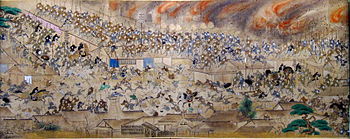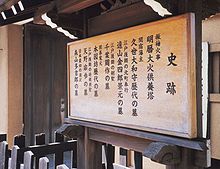- Great Fire of Meireki
-
Handscroll depicting scenes from the Great Fire of Meireki (kept at the Edo-Tokyo Museum)

The Great Fire of Meireki (明暦の大火 Meireki no taika), also known as the Furisode Fire, destroyed 60-70% of the Japanese capital city of Edo (now Tokyo) on March 2, 1657[1], this is the third year of the Meireki Imperial era. It lasted for three days, and is estimated to have claimed over 100,000 lives.
Contents
History
The fire began on the eighteenth day of the year, in Edo's Hongō district, and spread quickly through the city, due to hurricane force winds which were blowing from the northwest. Edo, like most Japanese cities and towns at the time, and like most of those in mainland East Asia, was built primarily from wood and paper. The buildings were especially dry due to a drought the previous year, and the roads and other open spaces between buildings were small and narrow, allowing the fire to spread and grow particularly quickly. (Many cities in Europe had similar problems, being built of flammable material and tightly packed; indeed, London was to burn only nine years later.) Though Edo had a designated fire brigade, the Hikeshi (火消し, "fire extinguishing"), it had been established only 21 years earlier, and was simply not large enough, experienced enough, or well-equipped enough to face such a conflagration.
On the second evening, the winds changed, and the fire was pushed from the southern edges of the city back towards its centre. The homes of the shogun's closest retainers, in Kōjimachi, were destroyed as the fire made its way towards Edo castle, at the very centre of the city. Ultimately, the main keep was saved, but most of the outer buildings, and all of the retainers' and servants' homes were destroyed. Finally, on the third day, the winds died down, as did the flames, but thick smoke prevented movement about the city, removal of bodies, and reconstruction, for several days further.
On the 24th day of the new year, six days after the fire began, monks and others began to transport the bodies of those killed down the Sumida River to Honjō, a community a short distance outside the city. There, pits were dug and the bodies buried; the Ekō-in (Hall of Prayer for the Dead) was then built on the site.
Reconstruction efforts took two years, as the shogunate took the opportunity to reorganize the city according to various practical considerations. Under the guidance of Rōjū Matsudaira Nobutsuna, streets were widened and some districts replanned and reorganized; special care was taken to restore Edo's mercantile center, thus protecting and boosting to some extent the overall national economy. Commoners and samurai retainers alike were granted funds from the government for the rebuilding of their homes, and the restoration of the shogun's castle was left to be completed last. The area around the castle, as it was restored, was reorganized to leave greater spaces to act as firebreaks; retainers' homes were moved further from the castle, and a number of temples and shrines were relocated to the banks of the river.
One of the greatest disasters in Japanese history, the death and destruction incurred by the Meireki fire was very nearly comparable to that suffered in the 1923 Great Kantō earthquake and the 1945 bombing of Tokyo in World War II. Each of these 20th century events, like the Meireki fire less than three centuries earlier, saw roughly 100,000 deaths, and the destruction of the majority of the city.
The fire was said to have been started by a Japanese priest who was cremating an alleged unlucky kimono. The kimono had been owned in succession by three teenage girls who all died before ever being able to wear it. Laura Joh Rowland's 2008 Novel "The Fire Kimono" , 13th in her Sano Ichiro detective/mystery series set in Edo revolves around a murder being investigated 43 years after the fire, with many flashbacks and descriptions of a fictionalized version of the events surrounding the fire, and the unlucky kimono said to have started the fire during its cremation, after claiming the lives of three successive teenage wearers. It was a long sleeved kimono, said (in the novel) to have been made and worn to impress a suitor.
Notes
- ^ Blusse, Leonard & Cynthia Vaillé (2005). The Deshima Dagregisters, Volume XII 1650-1660. Leiden
References
- Sansom, George (1963). "A History of Japan: 1615-1867." Stanford, California: Stanford University Press.
See also
- Fires in Edo
External links
 Media related to Great Fire of Meireki at Wikimedia CommonsCategories:
Media related to Great Fire of Meireki at Wikimedia CommonsCategories:- Fires in Japan
- Edo
- 1657 disasters
- 1657 in Japan
- 17th-century fires
Wikimedia Foundation. 2010.


